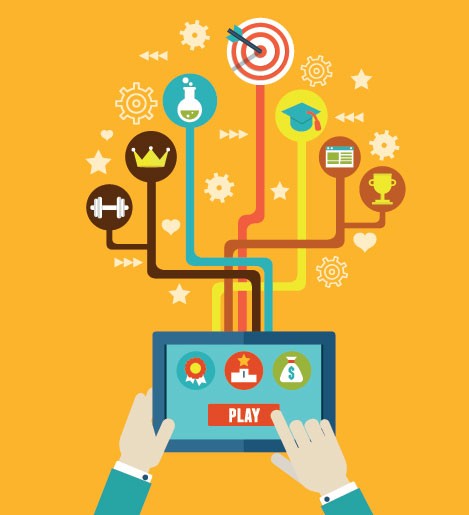Consumer-centric Gamification – Make Gamification work for your consumer (Part 2 of 2)
(This post is written in two parts, this being the second one and addresses the concerns that any Retail Enterprise faces while gamifying a consumer-end process or an element of the process.Read the first part here )
Many of my friends check-in via Foursquare religiously. On quizzing them about this preference, I realized that each one of them started checking-in for fun, but doing it constantly has turned it into a habit. The convenience of application design only made it easier for everyone to nourish this habit. “It’s not just about the convenience, though. It is also about having easy access to other users of the application. After I started using Foursquare, my friends were interested in knowing the reviews of all the restaurants I try. They knew that I was a foodie, but it was difficult to keep updating all of them about where I’ve been regularly,” added another Foursquare enthusiast. That brings me to:
4.Make the content of the game drive behavioral changes.
You have zeroed in on which aspect of business to gamify. The challenge that lies ahead is to present it in a way that appeals to your target audience. Competitive Analysis is a great way to solve any dilemma on this front. Carrying out a detailed study on the Gamification approaches of your immediate competition gives you some rare insights on solutions which have the end users addicted, which register the maximum app retention and which have succeeded in becoming an integral part of lives of many users. Whether you derive analogies, get inspired or unlearn & redesign, make sure that your gamified solution has a potential to drive behavioral changes.
The ongoing research on Gamification was interrupted by another client request. This time, I was assigned to redesign a high-performing trading application. I was inspired to “gamify” the trading application, but was apprehensive about it, as trading is complex and process oriented. But, the more I dwelled on it the more I realized the relevance of the approach. While the application promised a convenient trading process to seasoned traders, it did not address the preliminary needs of a large group of users who were new to mobile trading and needed to be coaxed into the bigger leagues. The gamification approach would be welcomed more by these users as we’ve just made the “bitter and unsavory” journey into the world of finance a whole lot easier.
Which brings me to:
5.Customize your Gamification strategy for your target audience.
We are living in an age where the average target user is increasingly aware: information, is both accessible and consumable the end-user has never been more empowered. But that isn’t what brands worldwide are excited about. Due to this increase in awareness, end-users respond to strategy in a methodical way. This is a striking contrast to the “chance-based” success rate, which has been the norm for a long time with consumer-centric solutions. With the gap between progress and learning decreasing by the day, it is much safer for your brand to strategically rollout a solution.
Since the requirement was to incorporate learning through this mobile application, I tried to do a small, fun exercise that promised results. I shared the request with each team member individually, and asked them to give one gamification idea for this application. Since, all the team members belonged to different working and education backgrounds, I had access to various viewpoints on the driving parameters for gamifying a process.
One of my teammates provided me with a valuable insight on the reward-system of Gamification, by explaining the reward strategies of various successful gamified entities. “Epic win is a great example of providing intangible, yet personal rewards. All a user has to do is create to-do lists with chores and tasks, complete them and the user’s avatar in the app replicates the growth.”
Which brings me to:
6.Provide intrinsic rewards to your user.
One of the core aspects of Gamifying a process or an aspect of the process, is the reward system. If the rewards conversion process of your gamified idea is complex or extensive, it reduces your chances at customer retention.Brand retention is about top-of-the-head recall; your end-user will not remember the amount of fun in your gamified solution, but instead will be left with the unpleasant memory of a difficult rewards conversion cycle. Moreover, if the conversion is integrated with partnership entities or other brands, then your value-chain is distributed. It is always safe to provide rewards which are already a part of your business eco-system, this enables two core benefits for your brand:
1.Since all your loyal consumers are well aware of all the elements of your brand eco-system, your enterprise does not have to spend time educating the users about rewards.
2.You have complete control over the rewards, as the permits and releases aren’t integrated with another partner or brand.
The bottom-line:
Gamification is one of the most bankable approaches because of the meteoric rise of social and mobile, the growth of the video game-influenced consumer set, and most importantly, the ever-evolving business performance needs of organizations. In addition, Gamification promises to create many positive, fun experiences that your customer will remember.
Gamification can engage an audience without coaxing them, drive convenience without affecting the fun quotient and make brand rewards much more meaningful. If brand solutions are about engaging and retaining consumers, then gamification promises your business exactly that.
![Blog-[x]cube LABS](https://d6fiz9tmzg8gn.cloudfront.net/wp-content/uploads/2016/06/blog_banner.jpg)


